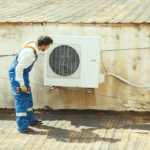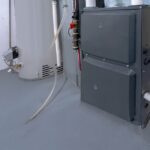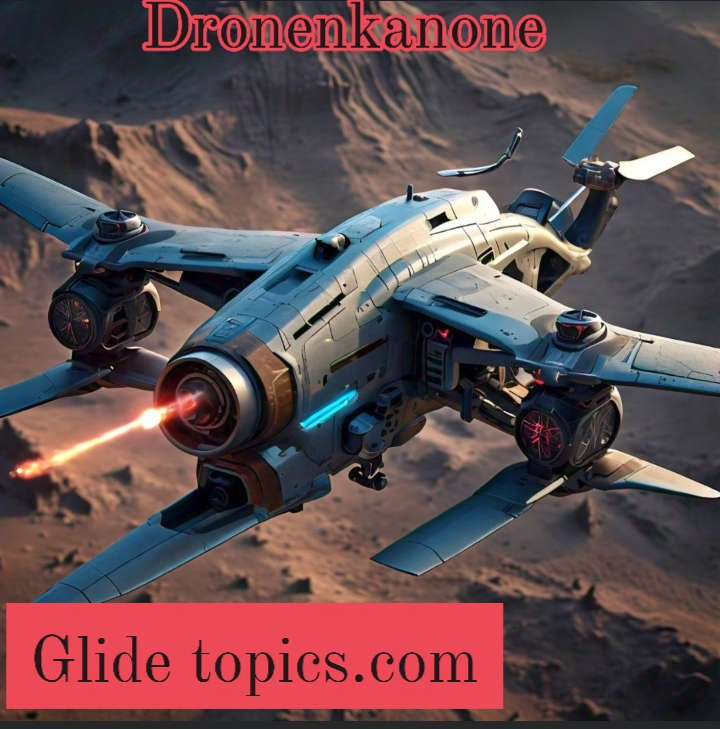In the age of rapidly advancing technology, drones have become an essential part of various industries such as military defense, surveillance, agriculture, and even entertainment. However, their increasing use has also led to growing concerns regarding safety, privacy, and unauthorized drone activities. This has prompted the development of innovative drone defense systems. Among these, the Dronenkanone stands out as an intriguing and potentially game-changing technology.
The term Dronenkanone, which translates from German as drone cannon, refers to a system designed to disable or destroy drones in flight. It typically uses electromagnetic pulses (EMPs) or other countermeasures to neutralize drones that are deemed a threat. In this article, we will explore what the Dronenkanone is, how it works, its applications, and the future of drone defense technologies.
Introduction: The Rise of Drones and the Need for Defense
Drones, or unmanned aerial vehicles (UAVs), have become a cornerstone of modern technology. From delivering packages and conducting surveillance to providing internet access and monitoring agricultural fields, drones are being used in countless ways. However, as their use has expanded, so has the potential for misuse.
Unauthorized drone activity, particularly in restricted airspaces or near sensitive areas such as military bases, government buildings, and critical infrastructure, has become a significant concern. This has led to the development of drone defense systems that can detect, track, and neutralize drones that pose a threat.
The Dronenkanone, or drone cannon, is one such defense system. It offers a non-kinetic means of disabling drones, making it a viable option for use in urban environments, airports, or sensitive sites where traditional anti-aircraft weaponry would be too destructive or impractical.
What is a Dronenkanone?
A Dronenkanone is essentially a counter-drone weapon that aims to neutralize unwanted or hostile drones. The term “Dronenkanone” is derived from the German words “Drohne” (drone) and “Kanone” (cannon), signifying its role as a drone-neutralizing artillery piece. While traditional guns and missiles have been designed to destroy larger airborne threats, a drone cannon is a more targeted, specialized system built for the smaller, more maneuverable UAVs.
Most Dronenkanonen work by disrupting the communication signals between the drone and its operator, effectively disabling it. This could be achieved through technologies such as:Electromagnetic Pulses (EMPs): EMPs can disable the electronic systems of drones by emitting a burst of electromagnetic energy that interferes with the drone’s communications and control systems.Radio Frequency Jamming: This technique disrupts the communication between the drone and its operator, causing the drone to either lose control or return to its home point.GPS Spoofing: By sending false GPS signals, the Dronenkanone can cause the drone to think it’s in a different location, often forcing it to land or return to its takeoff point.Lasers and Directed Energy: Some Dronenkanonen are equipped with lasers that can physically damage the drone’s sensors or cameras, rendering it ineffective.
How Does the Dronenkanone Work?
The Dronenkanone operates using a combination of detection, tracking, and neutralization technologies. Here is a breakdown of how the system typically works:
Detection and Identification
Before a drone can be neutralized, it must first be detected. This is usually achieved through the use of various sensors, including radar, infrared cameras, and acoustic sensors. These systems are designed to scan large areas for the presence of drones and identify their position in real time.
Once a drone is detected, its type, size, and trajectory are analyzed to determine if it poses a legitimate threat. The system may also attempt to classify the drone to ensure it’s not a harmless one (like a recreational drone) or part of a legitimate operation.
Tracking and Locking On
Once the drone is identified, the Dronenkanone employs tracking technology to follow the UAV’s movements. This could be done through radar tracking, optical tracking systems, or other advanced sensors that allow for precise control of the cannon.
The tracking system is designed to lock onto the target drone, predicting its flight path to ensure that the neutralization efforts are on point. Whether the system is using EMPs, jamming, or lasers, accurate tracking is critical to ensure the drone is disabled before it can reach its target or escape.
Neutralization
Once the drone has been locked onto, the Dronenkanone proceeds to neutralize the threat. Depending on the system, neutralization can occur through one of the following methods:EMP Pulse: A directed electromagnetic pulse is sent to disable the drone’s electronics, including its flight control systems, GPS, and communication systems. This typically causes the drone to lose control or drop from the sky.Radio Frequency Jamming: The system jams the frequencies that the drone uses to communicate with its operator. Without communication, the drone either falls into a fail-safe mode (such as returning to its point of origin) or loses power and crashes.Laser Weaponry: Some Dronenkanonen use powerful lasers to damage or disable the drone’s internal components, including the camera, sensors, or power supply. This causes the drone to either malfunction or crash.
Applications of the Dronenkanone
Military and Defense
The most significant application of the Dronenkanone is in the military and defense sectors. Military forces worldwide are increasingly concerned about the use of drones for espionage, surveillance, and even armed attacks. In conflict zones or sensitive areas, drones can be a serious threat, capable of carrying explosives or spying on strategic locations.
Dronenkanonen provide a non-kinetic means of defending military airspace without risking collateral damage. Instead of using traditional anti-aircraft missiles that may destroy a drone but also cause damage to the surrounding environment, the Dronenkanone disables drones without causing massive destruction.
Protection of Critical Infrastructure
Another key application for Dronenkanonen is the protection of critical infrastructure such as airports, power plants, and government buildings. Unauthorized drone activity around airports, for example, has raised concerns about security risks and airspace violations.
By employing a Dronenkanone to neutralize suspicious drones, authorities can prevent potential threats from compromising air travel, espionage, or sabotage. Similarly, military bases, nuclear plants, and prisons often use such systems to keep unauthorized drones away from sensitive areas.
Law Enforcement and Public Safety
In cities and urban environments, Dronenkanonen could be deployed to safeguard public events such as sports games, political rallies, or concerts, where the presence of drones could pose a risk to public safety. Additionally, law enforcement agencies could use this technology to counteract illegal drone surveillance or malicious use by criminals.
The ability to disable drones without causing collateral damage makes the Dronenkanone an ideal choice for law enforcement agencies, allowing them to respond quickly and efficiently to drone-related threats.
Wildlife and Environmental Protection
In some cases, drones have been used to illegally poach wildlife, engage in illegal fishing, or trespass on protected land. Dronenkanonen can be deployed in such environments to help authorities protect animals, natural resources, and ecosystems from drone-related crimes.
Challenges and Controversies
While the Dronenkanone has the potential to revolutionize drone defense, there are also challenges and controversies surrounding its use.
Ethical Concerns
The use of drone neutralization technology raises ethical questions about privacy and the right to use drones for legitimate purposes. For instance, what happens if an innocent civilian drone is mistakenly neutralized? How do we ensure that these systems are not misused for surveillance or other illegal activities?
Legal Issues
The legality of deploying counter-drone technologies like the Dronenkanone is still in question in many regions. Governments must navigate complex regulations regarding airspace control, civilian drone use, and the use of force. Without proper regulation and oversight, there could be unintended consequences, such as interfering with commercial drones or violating privacy rights.
Technological Limitations
While promising, the current generation of Dronenkanonen still has some limitations. For example, high-powered EMP devices could interfere with other essential systems, such as communications networks or even nearby electronic devices. The power and range of laser weapons can be limited, requiring close proximity to effectively disable drones.
Conclusion: The Future of Drone Defense
The rise of drones presents both an opportunity and a challenge. While they offer numerous benefits, they also bring with them a new range of threats, especially in military, industrial, and urban environments. The Dronenkanone offers an innovative solution to neutralize rogue drones effectively, offering a non-kinetic, targeted approach to counter-drone defense.
As technology continues to evolve, the capabilities of Dronenkanonen are expected to improve, providing better protection for sensitive areas and critical infrastructure. However, for widespread adoption, the ethical, legal, and technological issues surrounding their use will need to be addressed.
FAQs
1. What is a Dronenkanone?
A Dronenkanone is a counter-drone weapon system designed to neutralize unauthorized or hostile drones using non-kinetic means such as EMP pulses, radio frequency jamming, or laser weapons.
2. How does a Dronenkanone work?
The system works by detecting, tracking, and then neutralizing drones using various technologies like electromagnetic pulses or radio frequency jamming, which disable the drone’s control systems.
3. Where are Dronenkanonen used?
Dronenkanonen are primarily used in military defense, critical infrastructure protection, law enforcement, and wildlife conservation, where they help neutralize unauthorized or malicious drone activity.
4. Are Dronenkanonen effective against all drones?
While highly effective against many consumer-grade and military drones, the effectiveness of a Dronenkanone depends on the type of drone, its range, and the neutralization technology used.
5. Are there any legal issues with using Dronenkanonen?
Yes, the use of counter-drone technologies raises legal and ethical concerns, particularly regarding airspace control, privacy rights, and the potential for misuse in non-combat situations.










